Affiliate disclosure: This post may contain affiliate links. Please see our Privacy Policy.
Herbal wines and herbal mead (Metheglin) were once incredibly common. They were consumed daily in the middle ages, alongside herbal beers (known as gruit). Some were simply flavored with herbs, while others were potent medicinals. Regardless of your goals, the process for making herbal wines and meads is the same, and you can use almost any edible or medicinal herb.
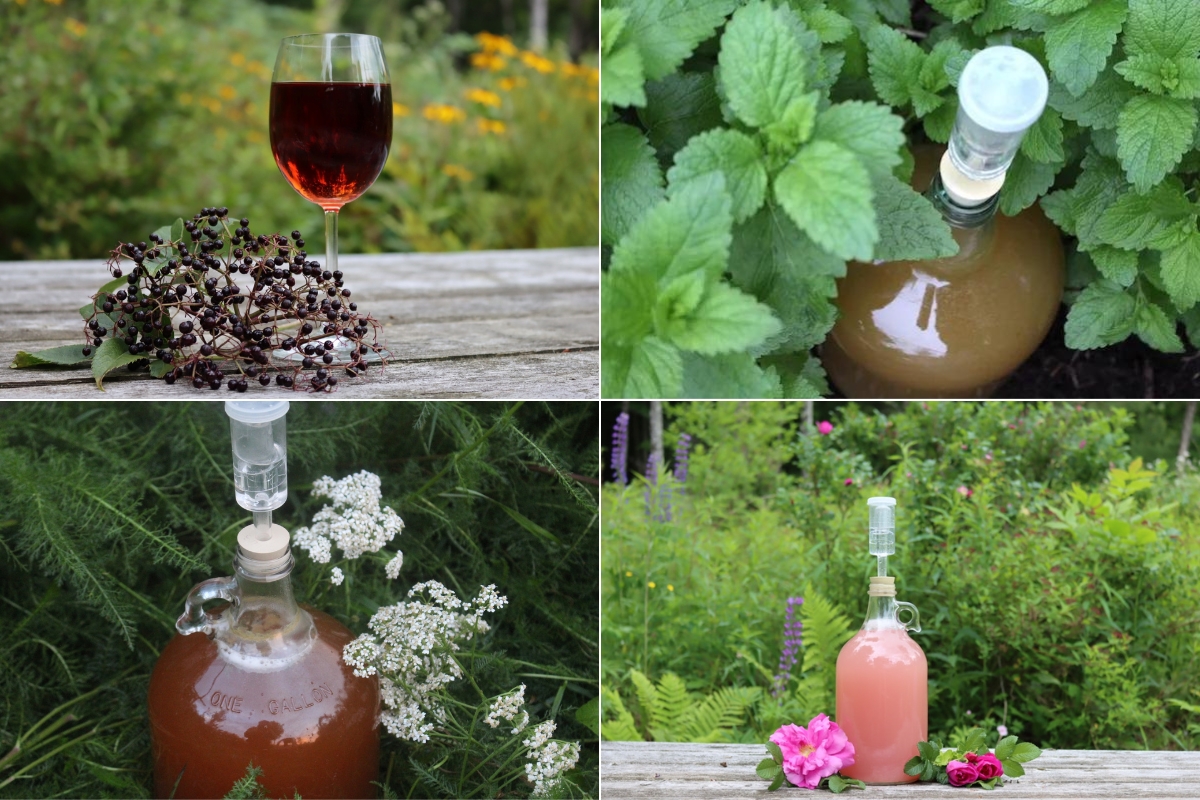
Historically, herbal wines, meads, beers, and ales were just another way to take your medicine.
Sometimes herbs were used for flavoring and preservation in these brews, as hops are today, but often they were actually made for medicinal reasons. A homemade herbal wine or mead is a great way to preserve medicinal herbs in a shelf-stable and ready-to-use way.
Think of it like herbal tinctures that we use today, but simpler to make at home from scratch from ingredients you could gather in the wild in the middle ages (like herbs and honey).
Herbal tinctures are much the same, but they use distilled alcohol as a solvent to extract the medicinal constituents in the herbs. Since distilled alcohol involved more equipment to make yourself (historically at least, as it’s illegal to make it yourself these days) and it’s always been expensive to buy, making herbal wines and meads was a simple solution.
Beyond that, many herbs have both alcohol-soluble and water-soluble medicinal properties, and wine is better at extracting both.
Generally, tinctures are made with high-proof spirits, and don’t pull out all the water-soluble constituents in the herbal material. A wine or mead, on the other hand, will be somewhere between 12 and 20% alcohol, depending on how it’s made.
That’s enough to ensure it’s shelf stable, and just the right balance of alcohol and water to pull out all the goodness from the herbs.
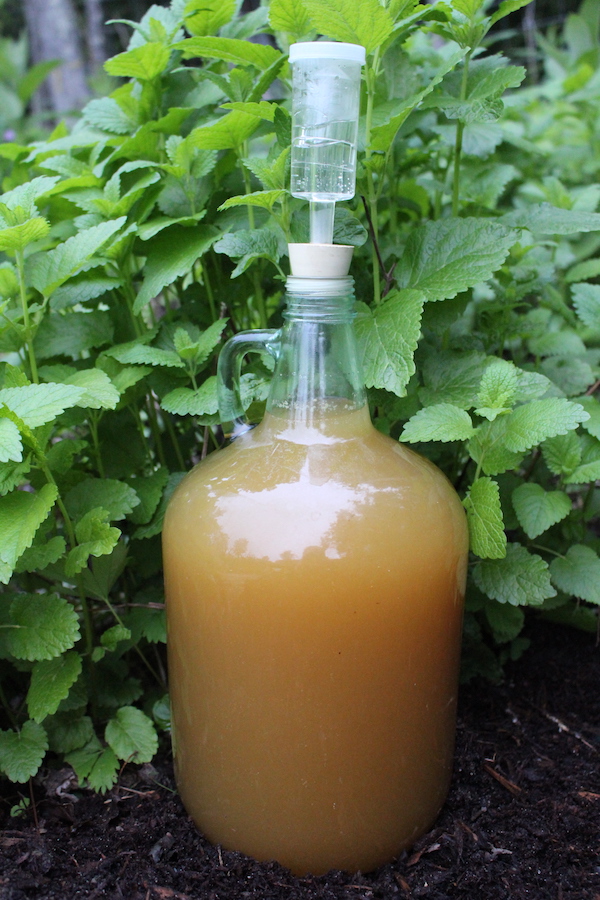
My goal here is to walk you through the process of making wine or mead from any herb, and also to point you in the direction of further resources if you want to dive deeper into the craft of herbal wines. If you are seriously interested in learning all there is to know about herbal wines, I’d suggest taking The Craft of Herbal Fermentation from the Herbal Academy of New England. They cover wine, mead, kombucha, lacto-ferments, and more in an easy-to-understand online course with plenty of recipes.
If you’re just starting out with winemaking, I have a comprehensive series that walks you through every step of the process. If you find yourself needing more details while following this herbal wine guide, you can check out any of these deeper dives:
- Beginner’s Guide to Making Fruit Wines: This guide covers all the essential steps in the winemaking process, perfect for beginners.
- Small Batch Winemaking: Ideal for making smaller quantities—sometimes as little as one bottle at a time. The process and equipment differ from traditional batch winemaking.
- How to Make Mead (Honey Wine): While similar to fruit wines, mead has unique considerations due to the use of honey, and I’ve broken it down for you.
- Essential Winemaking Equipment: Here, I detail all the key tools and equipment you’ll need for your first batch (besides your ingredients).
- Ingredients for Winemaking: This guide covers everything you’ll need, from fruits and herbs to other ingredients like sugar, water, and acid.
- Yeast for Winemaking: Yeast selection can be tricky with so many strains to choose from. I’ve broken it down to help you choose the best one for your wine.
- Winemaking Recipes: Finding good recipes can be a challenge, but I’ve compiled over 50 to help you get started.
- Meadmaking Recipes: Recipes for mead can be harder to come by, but I’ve gathered a selection of tried-and-true options for you.
These guides should help you with every aspect of making your own herbal wines, whether you’re just starting out or refining your technique!
I also have a specific guide to making floral wines and meads, and many of these edible flowers are also medicinal flowers as well. Recipes like elderflower wine (and mead) and Rose wine (and mead) qualify as both herbal wines as well as floral wines.
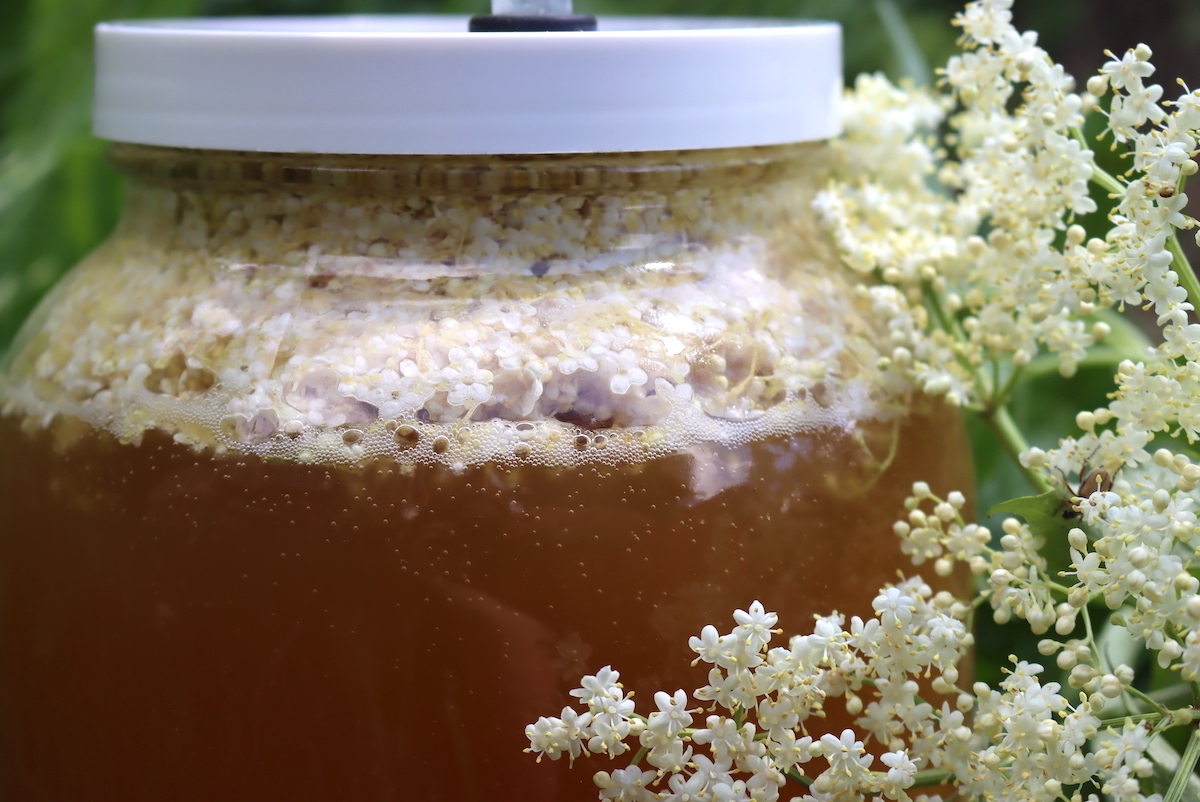
Ingredients for Herbal Wines & Meads
Making herbal wines and meads is a straightforward process, and the ingredients are fairly simple, much like making fruit wines. Herbs are primarily used for their flavor and medicinal properties, but the main source of fermentable sugar comes from honey (for meads) or regular sugar (for herbal wines). Since herbs lack the natural acidity and tannins found in fruits, you’ll need to add lemon juice (or an acid blend) and tannin powder (or even black tea) to balance the flavor profile.
In addition to these, a bit of yeast nutrient powder is necessary to support the yeast. Unlike grapes, herbs don’t provide the same micro-nutrients that yeast requires to thrive, so the nutrient helps ensure the fermentation process goes smoothly.
Here’s a basic breakdown of the ingredients for making a herbal wine or mead:
The basic recipe for a herbal wine is as follows:
- 1 cup to 1 quart of herbal material
- 5 1/2 to 6 cups sugar (or 3 lbs honey for mead)
- 1/4 cup lemon juice
- 1 tsp yeast nutrient
- 1/8 to 1/4 tsp wine tannin
- 1 packet wine yeast
I’d suggest referring to my guide on ingredients for winemaking if you’d like to learn more about why each ingredient is important and what you can substitute if you don’t have that specific thing on hand.
That said, here are the basics:
Herbs
The herbs you choose for your herbal wine depend on your goals, both in terms of flavor and in terms of medicinal value. You don’t have to choose medicinal herbs, and a simple lemon balm mead is absolutely delicious even if you’re not focused on making medicinal mead.
Be aware that not every herb mixes well with alcohol, though many do. Most of the common ones that are used in the kitchen or in herbal teas work well with alcohol, but it’s always a good idea to check into the specific herbs you intend to use.
A good resource for this is the The Craft of Herbal Fermentation course from the herbal academy, which I mentioned earlier, but I’d also recommend the book Sacred Herbal Healing Beers. While the title says “beer” it does in fact cover all manner of ferments, and many of the recipes included are for herbal “ales” which are made with sugar instead of malt…so they’re also technically herbal wines.
The main thing here is you want to check with a reputable source to determine if the herb you’re using is safe with alcohol, and in the amounts or concentrations you’ll be consuming when the brew is finished.
Again, most common herbs work well here, but there are some more potent medicinals that shouldn’t be taken lightly.
The Compleat Meadmaker suggests the following herbs for meads:
- Angelica
- Bergamot
- Borage
- Cardamom
- Chamomile
- Fennel
- Ginger
- Hops
- Juniper Berries
- Lavender
- Lemon Balm
- Lemon Grass
- Lemon Verbena
- Mint
- Rose
- Rose Hips
- Saffron
- Sweet Woodruff
- Turmeric
- Vanilla
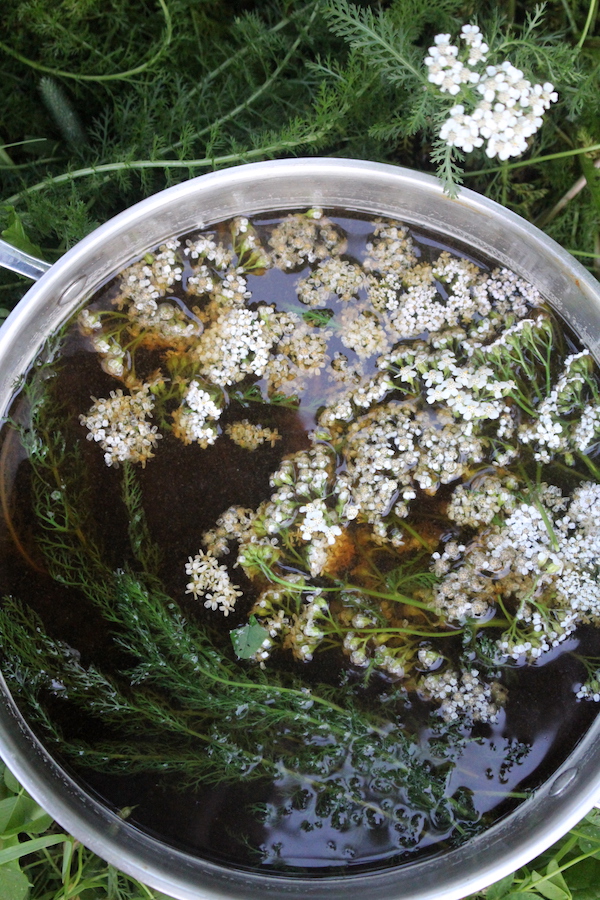
Sugar or Honey
Since you’re not working with fruit, you do need to provide something to feed the yeast. If you use sugar, the result will be what’s known as a “country wine,” while honey based beverages are called meads (or Metheglin).
As a general rule, you’ll need about 3 lbs per gallon, but the total amount can vary based on how much residual sugar you’d like (ie. sweetness) and the type of yeast you’re using.
Beleive it or not, the sweetness at the end will mostly be determined by how vigorous the yeast is, and that varies by strain.
A yeast that finishes at 12% alcohol will result in a sweeter wine than a stronger champagne yeast that finishes at 18% alcohol, assuming you start both with the same amount of sugar. If the sugar is converted to alcohol, it won’t contribute to sweetness in the finished wine.
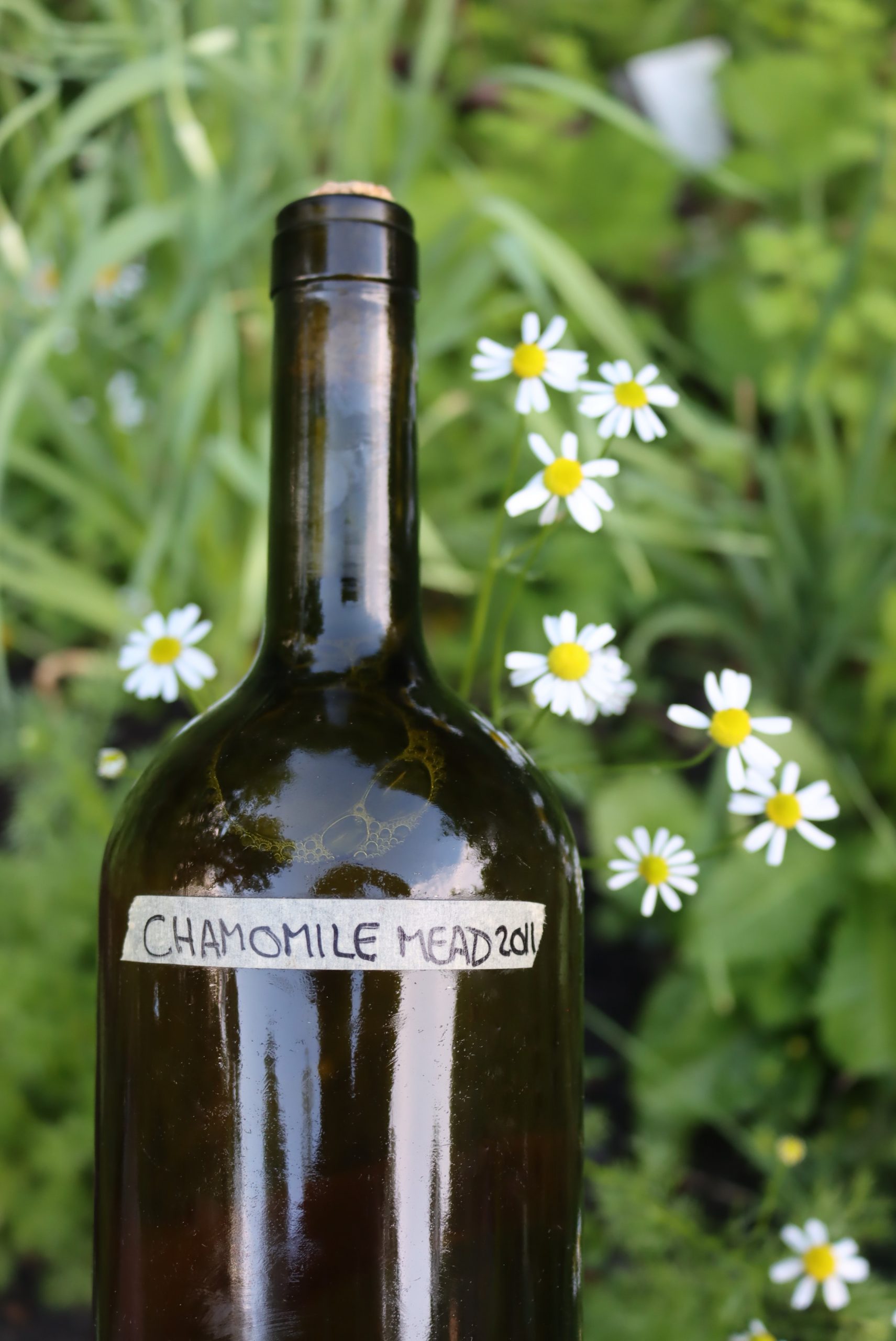
Lemon Juice
Yeast need an acidic environment to thrive, but more importantly, some types of spoilage bacteria can take over if the ferment isn’t started in an acidic environment.
When you’re working with fruit, it’s naturally acidic, but herbs don’t really impact the pH and the mixture will start out pretty neutral.
It’s important to add lemon juice or powdered acid blend (a common winemaking ingredient) to drop the pH to ensure success. (This is not optional.)
Yeast Nutrient
Sugar is calories, but it’s not a balanced diet for yeast. They need other nutrients to thrive, and most of those are naturally present in wine grapes. But other fruits don’t have yeast nutrients in the right concentrations, and herbs don’t really have anything to feed the yeast.
When working with herbal wines, you do need to add either powdered yeast nutrient or a handful of raisins to the batch. Yeast nutrient is more dependable and neutral tasting.
Wine Tannin
Tannin contributes to the mouthfeel and perceived “body” of a finished wine, and greatly enhances your experience when you’re drinking the finished product. Wines without tannin will taste thin and unbalanced.
This is entirely a taste thing, and tannins aren’t required for successful fermentation.
Some herbs actually contain natural tannins (and wine grapes also contain natural tannins). If you get a “dry” feeling in your mouth when you drink a herbal tea made from the herbs you’ve chosen, there’s a good chance they have natural tannins. (Black tea has natural tannins, for example, as do grape and currant leaves.)
Wine tannin is a simple tannin powder that you can add in very small amounts (literally a pinch to a gallon) and it can make a huge difference in the flavor of the finished wine. It is optional but highly recommended.
You can also add 1 cup of strongly brewed black tea per gallon for a similar effect.
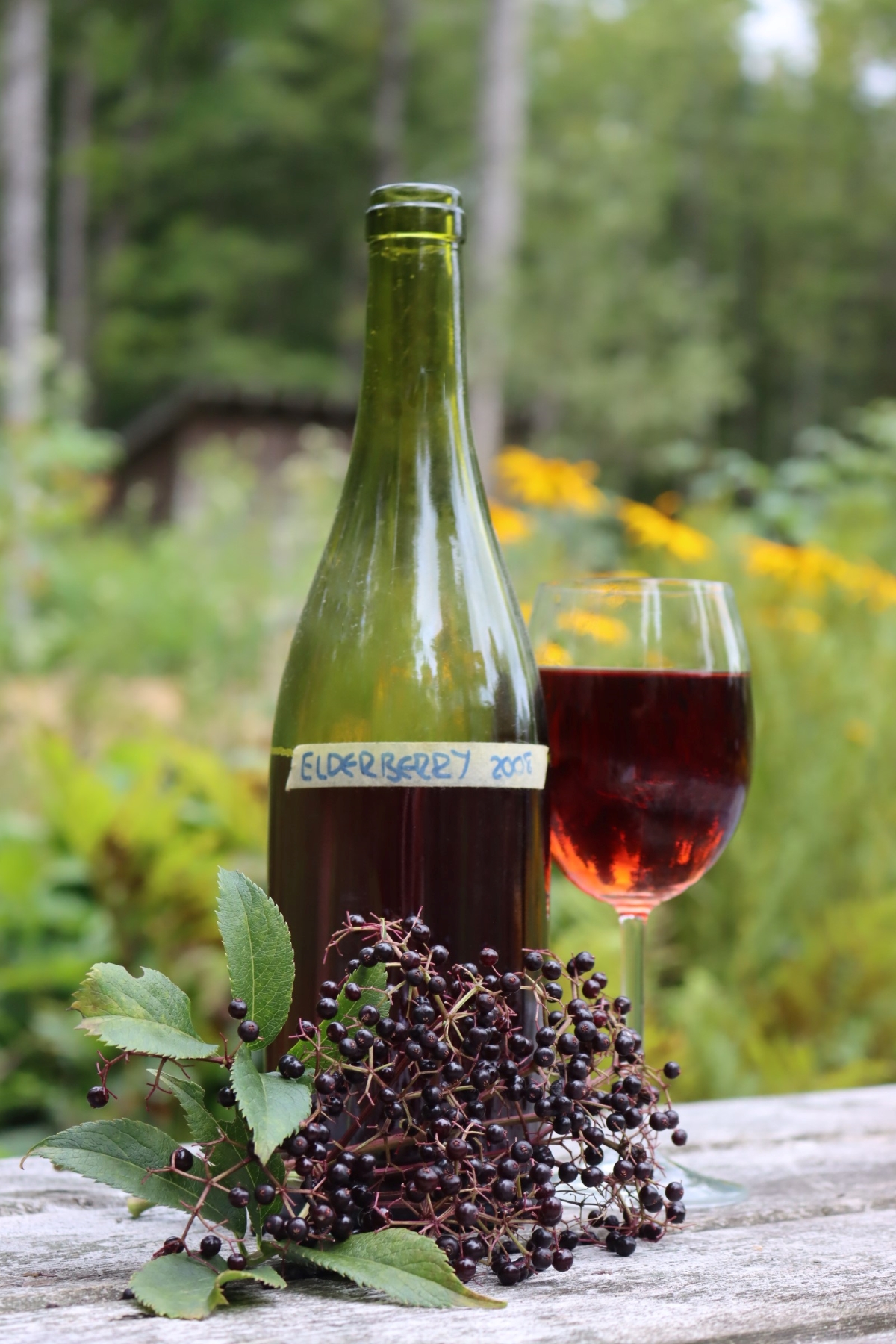
Wine Yeast
Believe it or not, a lot of the flavor in your finished wine will be contributed by the yeast. Different strains of yeast contribute floral or fruity esters, while others taste tropical or spicy. Each yeast will add a different flavor, and also has a different alcohol tolerance.
The alcohol tolerance determines when the yeast will die out, effectively stopping fermentation, and stabilizing the wine at a certain ABV %. When the yeast reach their alcohol tolerance, the remaining sugar will be left behind…so the sweetness of the finished wine is determined as much by the sugar in the recipe as it is by the alcohol tolerance of the yeast strain.
In the middle ages, certain structures and locations were known for their brews, namely timber framed buildings and wineries where yeast lived literally in the timbers.
These days, we’re not relying on yeast inoculation from the environment, and as a result, you can make wonderful herbal wines just about anywhere just by adding the right yeast.
Herbal wines can use a variety of yeast strains, but some of the most common choices are listed below. They range from 12% up to 18% alcohol tolerance, which will allow you to choose how alcoholic (and also how sweet) you want your finished wine or mead:
- Red Star Cote des Blancs ~ A slow fermenter that gently brings out subtle fruit and floral esters during fermentation. It’s often used for apple wines, floral wines and sweet fruity wines since it retains many of the volatile flavors that other more vigorous yeasts can drive off. When working with herbal wines, this one is best for subtle, delicate flavors like lavender. Alcohol tolerance to 12-14%, ideal temperature range 64 to 86 F.
- Lavin D47 ~ Adds a fruity and spicy aroma to the finished wine, and works well with “spicy” herbs like cinnamon, cloves, ginger and others with more of a spice character. Also brings out some tropical fruit and citrus notes in the finished wine, which work well with spices too. Moderately vigorous, and may be slow to start fermentation. Alcohol tolerance to 15%, ideal temperature range 59 to 86 F.
- Lalvin K1-V1116 ~ A dependable fermenter that works well in difficult fermenting conditions (low/high temperatures, low nutrients, etc). You’ll need to add a bit more sugar with this yeast, or you’ll end up with a very dry wine. High alcohol tolerance, up to 18%, and an incredible temperature range from 50 to 95F.
Beyond these choices, I also have a guide to choosing wine yeast with dozens of other options.
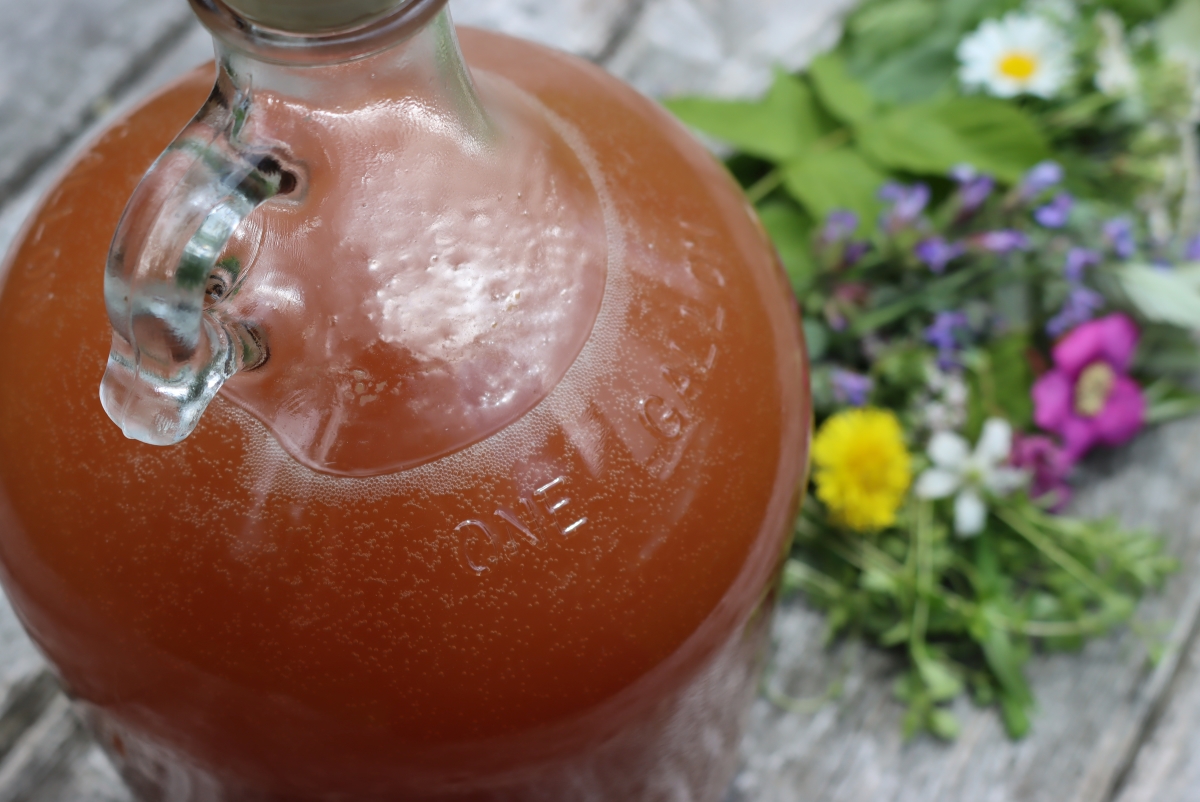
Equipment for Herbal Wines and Meads
While winemaking can seem like a complex process, the equipment needed doesn’t have to be intimidating. Many of the tools typically used in winemaking are optional, and chances are, you already have suitable substitutes in your kitchen. My guide to winemaking equipment goes over each item and offers alternatives using everyday kitchen tools, so you can make wine without having to invest in specialized gear.
Here’s a basic list of the essential equipment you’ll need for winemaking:
- One Gallon Glass Carboy (two)– A narrow-neck glass vessel used for fermenting your flower wine. You’ll need two carboys: one for the primary fermentation and another to transfer the wine into after 7-10 days, leaving behind any sediment. These often come in kits with a rubber stopper and water lock included.
- Rubber Stopper and Water Lock – This combination works as a one-way valve, allowing carbon dioxide (CO2) to escape while keeping outside contaminants from getting into the fermentation vessel. It’s essential for preventing the wine from turning into vinegar during the fermentation process.
- Brewing Siphon – This tool is used to transfer the wine from one container to another, especially when you’re bottling it. It’s helpful for moving the wine while avoiding disturbing any sediment at the bottom of the fermenter.
- Wine bottles – The best option for storing your flower wine long-term. While wine bottles are ideal, you can also use beer bottles or flip-top Grolsch bottles for shorter-term storage if necessary.
- Bottle Corker– If you’re using wine bottles, a corker is required to seal them properly. Be sure to use fresh, clean corks for bottling the wine to avoid contamination.
- Brewing Sanitizer – A one-step, no-rinse sanitizer is key for cleaning all your equipment before use. It’s important to sanitize everything that will come into contact with the wine to ensure a safe fermentation and to prevent any off-flavors or spoilage.
Making Herbal Wines and Mead
This basic process can be used to make herbal wine with any edible herb, whether cullinary or medicinal. The herbs can be fresh or dried, but when dried, you usually only need about half as much because the flavors are more concentrated. The total amount of herbal material used will depend on the herb you’ve chosen, but generally, the process is the same regardless of the type.
To make a mead, you use honey instead of sugar and allow the wine to ferment a good bit longer (the yeast convert honey to alcohol a bit slower than they work on sugar).
Infuse the Herbs
You can do a cold infusion right in the fermenter, which works well for delicate herbs like lavender or chamomile, or a hot infusion before starting the wine (basically using herbal tea in place of water in the recipe). Hot infusions work well for tougher more durable herbal material, like roots and stems, but also dried berries like elderberry, rose hips and hawthorn.
With anything that has a lot of delicate volatile flavors, like flowers, I usually opt for “cold infusion” as it helps them retain more of their volatile aromas and flavors. That can be tricky in a traditional narrow-neck carboy, so I usually start cold infusions in a wide-mouth fermenter.
This is how I make my dandelion wine each year, as the petals can mat together in the fermenter and clog the waterlock, preventing all the bubbles from escaping…and eventually resulting in a big mess.

If doing a cold infusion, place the herbal material into the fermenter. Next, bring the water and sugar to a boil on the stove, stirring to dissolve. Allow the mixture to cool completely, and then pour over the flowers in the fermenter (along with the remaining ingredients, except the yeast. This includes yeast nutrients, lemon juice, and tannin powder).
If doing a hot infusion, add the herbs to the water as it’s heating on the stove and then strain out before placing the herbal tea into the fermenter (in place of water).
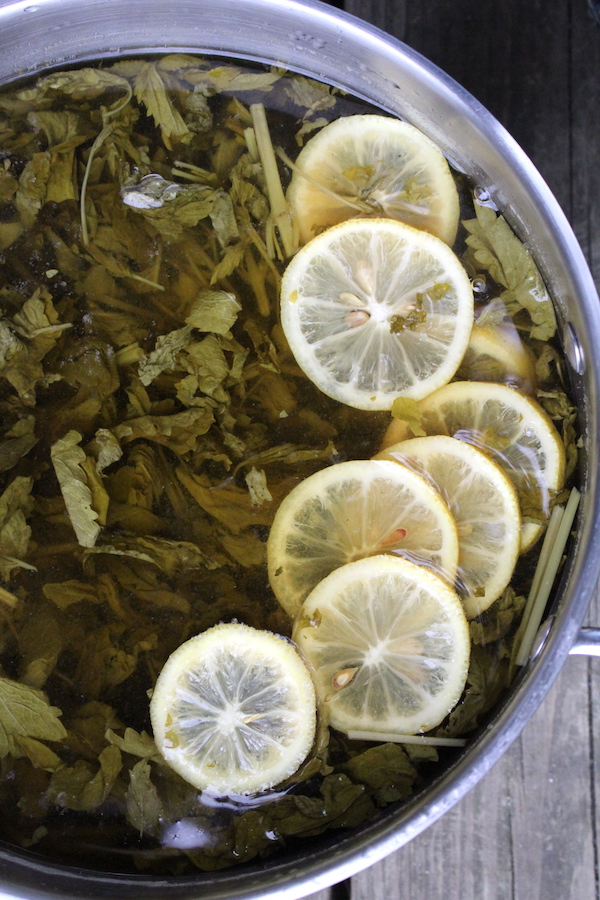
Add Yeast
Yeast is introduced to the wine right before the fermentation process begins. To prevent yeast shock, it’s important to rehydrate the dried yeast in a small amount of plain water before adding it to the mixture. If you’ve used warm water to prepare an herbal tea (instead of a cold infusion), make sure the wine mixture has cooled down to room temperature before adding the yeast.
Once the yeast is added, it should begin to bubble and foam within 24 to 72 hours as fermentation kicks off.
Primary Fermentation
The first phase of fermentation, called primary fermentation, lasts anywhere from 7 to 14 days. During this time, the yeast will multiply rapidly, working quickly and creating a lot of sediment at the bottom of the fermenter.
At this stage, there is little alcohol, and primary fermentation often occurs in an open container covered with a cloth or towel. While an airlock isn’t absolutely necessary during primary fermentation, I recommend using one if you have pets or small children in the house to prevent contamination.
Racking
Once the initial fermentation slows down and the wine has completed its primary stage, it’s time to rack the wine. This means transferring the liquid into a new, clean container. A siphon is used to do this gently, ensuring that the sediment (known as “lees”) at the bottom of the fermenter doesn’t get disturbed. Leaving wine on the lees for too long can cause off flavors, so this step is essential.
The herbal material is filtered out during racking, leaving you with just the liquid that will continue fermenting in the next stage.
Secondary Fermentation
After racking, the wine moves into secondary fermentation. At this point, you’ll seal the fermenter with an airlock. This allows carbon dioxide (CO2) to escape while preventing oxygen from entering, which helps prevent the alcohol from turning into vinegar.
Secondary fermentation typically lasts around a month, but depending on the recipe, it can take longer—especially for mead, which can require 2 to 4 months in secondary due to the slow fermentation of honey. The wine should be stored in a cool, dark area, ideally between 65 and 68°F (18 to 20°C), away from direct sunlight.
Tasting and Adjusting
Once the secondary fermentation has finished, it’s time to taste the wine. Keep in mind that it will still be “rough” at this stage, as it hasn’t had time to bottle-age yet, but it will give you a general idea of the flavors to expect. If the wine is too dry, you can add sugar or honey to sweeten it; if it’s too sweet, you can increase acidity to balance it out. Adjusting the tannin levels can help round out the flavors as well.
If the wine tastes balanced and ready, you can proceed to bottling. If not, make your adjustments, and if necessary, rack it into a fresh container for a brief tertiary fermentation period to allow the changes to settle.
Tertiary Fermentation (optional)
If you made adjustments to the wine, it may need a short tertiary fermentation—usually lasting a couple of weeks—to allow everything to settle and the wine to stabilize before bottling.
Bottling
When you’re ready to bottle, use a siphon to transfer the wine into clean wine bottles. Seal the bottles with corks to prevent air from entering.
Some winemakers choose to add potassium sorbate at this stage to stop any further fermentation, but I personally don’t use it. I find that if the secondary fermentation lasts long enough and I rack into tertiary if needed, the yeast activity will have died down, and the wine will be stable for bottling.
Once the wine is bottled, allow it to “bottle condition” for at least 2 weeks, but preferably at least 2 months, before drinking. It’ll taste a lot better after a bit of time to settle in the bottle, trust me.
But after that, enjoy!
Herbal Wine & Mead Recipes
I’ve included a basic recipe for herbal wines or meads in the printable recipe card below. That said, sometimes it’s nice to work from specific tested recipes with the specific herbs you’re going to be using.
In that case, take a look at any of these herbal wine recipes:
- Lemon Balm Mead
- Rose Petal Wine (and Mead)
- Elderflower Wine (and Mead)
- Elderberry Wine
- Rose Mead or Rhodomel Recipe
- Rose Hip Mead
- Spiced Hawthorn and Rose Hip Mead
- Ginger Mead
- St. Johns Wort and Cherry Herbal Mead
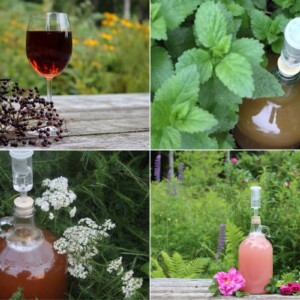
Herbal Wine (or Mead)
Ingredients
- 1 cup to 1 quart of herbal material, fresh or dried, edible or medicinal
- 5 to 6 cups sugar, or 3 lbs honey
- 4 to 6 cups white grape juice, optional, see note
- 1/4 cup lemon juice
- 1 tsp yeast nutrient
- 1/8 to 1/4 tsp tannin powder
- 1 wine yeast, see notes
Instructions
- First, decide whether you’re making herbal wine (with sugar) or mead (with honey). The ingredients are almost identical, except that mead uses honey in place of sugar. For herbal wine, adding 4 to 6 cups of white grape juice in place of some of the water can help enhance the body of the wine, but this is optional. Mead, with its natural richness from honey, doesn’t require the grape juice. If you do use grape juice in your herbal wine, reduce the sugar by about 1/2 to 1 cup.
- In a large stockpot, pour in about half a gallon of water and bring it to a boil. Stir in your sugar or honey until it's completely dissolved. Once fully mixed, remove the pot from the heat and let the liquid cool completely before continuing. If you’re infusing herbs with heat, add them to the pot now that it’s off the stove. For a cold infusion, skip this step and move to the next.
- If you're doing a cold infusion, place your herbs directly into the primary fermenter. Then, pour the cooled sugar or honey-water mixture over the herbs.
- Now, add the rest of your winemaking ingredients (except for the yeast) and stir to combine them thoroughly. This is the point where you can adjust any other flavors or additions, depending on your recipe.
- Fill the fermenter with cool water, leaving just enough space at the top of the container for the fermentation process. If you're making mead, you may need to add more water since you won’t be using grape juice. Make sure the mixture has cooled down to room temperature and is no hotter than 90°F (32°C) before moving on.
- Dissolve your yeast packet in 1/4 to 1/2 cup of room-temperature water and let it rehydrate for about 10 minutes. Once it’s ready, add the yeast-water mixture to the fermenter.
- If needed, top off the fermenter with additional water to fill it up to the neck. Seal the container with a rubber stopper and attach a water lock to allow gases to escape while preventing contaminants from entering.
- Allow the fermentation to take place for about 10 to 14 days. During this time, the yeast will be actively working, and you should notice bubbles in the water lock. Once fermentation slows down, you'll know primary fermentation is complete.
- Once the primary fermentation is done, use a siphon to transfer the wine or mead to a clean fermenter. Be sure to leave the sediment behind and strain out any herbal material. If you’ve been using a wide-neck fermenter, it’s a good time to switch to a narrow-neck vessel. Seal it again with a water lock and leave it to ferment in secondary. Herbal wine typically stays in secondary for about 4 to 6 weeks, while mead should ferment for at least 4 months.
- When secondary fermentation is complete, it’s time to bottle your herbal wine or mead. For wine, allow it to bottle condition for a minimum of 2 weeks. Mead requires at least 2 months of bottle aging before it's ready to enjoy. While Grolsch-style flip-top bottles are fine for short-term storage, wine bottles with corks are best for long-term storage, especially if you plan to keep your wine for more than 2 to 3 months.
Notes
- Red Star Cote des Blancs ~ A slow fermenter that gently brings out subtle fruit and floral esters during fermentation. It's often used for apple wines, floral wines and sweet fruity wines since it retains many of the volatile flavors that other more vigorous yeasts can drive off. When working with herbal wines, this one is best for subtle, delicate flavors like lavender. Alcohol tolerance to 12-14%, ideal temperature range 64 to 86 F.
- Lavin D47 ~ Adds a fruity and spicy aroma to the finished wine, and works well with "spicy" herbs like cinnamon, cloves, ginger and others with more of a spice character. Also brings out some tropical fruit and citrus notes in the finished wine, which work well with spices too. Moderately vigorous, and may be slow to start fermentation. Alcohol tolerance to 15%, ideal temperature range 59 to 86 F.
- Lalvin K1-V1116 ~ A dependable fermenter that works well in difficult fermenting conditions (low/high temperatures, low nutrients, etc). You'll need to add a bit more sugar with this yeast, or you'll end up with a very dry wine. High alcohol tolerance, up to 18%, and an incredible temperature range from 50 to 95F.
Herbal Resources
Looking for more types of herbal preparations you can make at home?
- How to Make Herbal Tinctures
- How to Make Herbal Glycerites
- How to Make Herbal Salves
- How to Make a Herbal Oxymel
- Homemade Herbal Shampoo
Winemaking Recipes
Looking for more winemaking recipes and mead recipes?
- Apple Wine
- Banana Wine
- Blackberry Wine
- Blueberry Wine
- Cherry Wine
- Lemon wine
- Cranberry Wine
- Rose Wine
- Lilac Wine
- Dandelion Wine
- Peach Wine
- Raspberry Wine
- Strawberry Wine
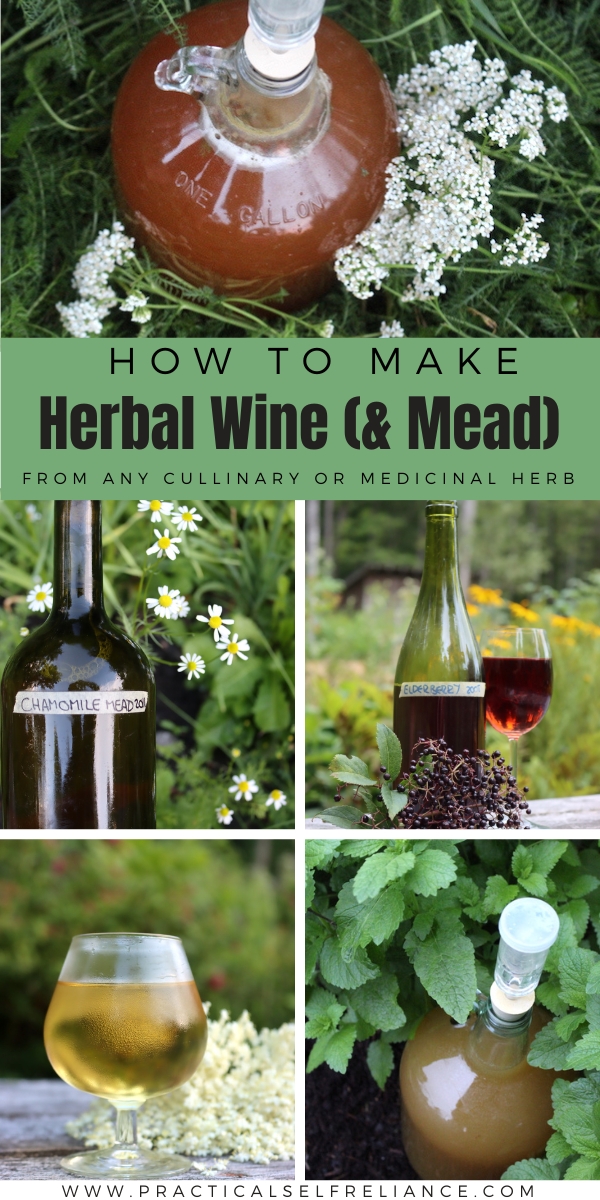


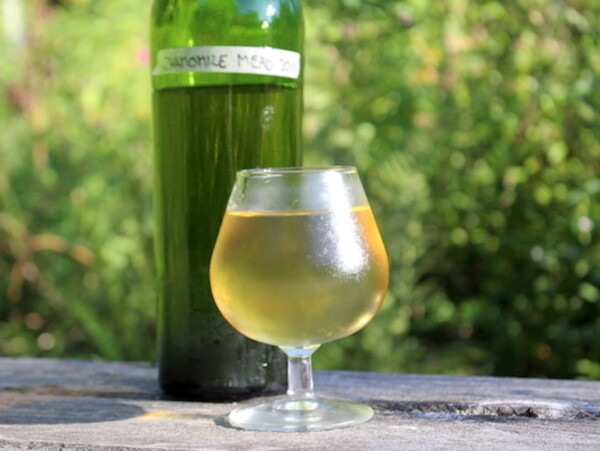
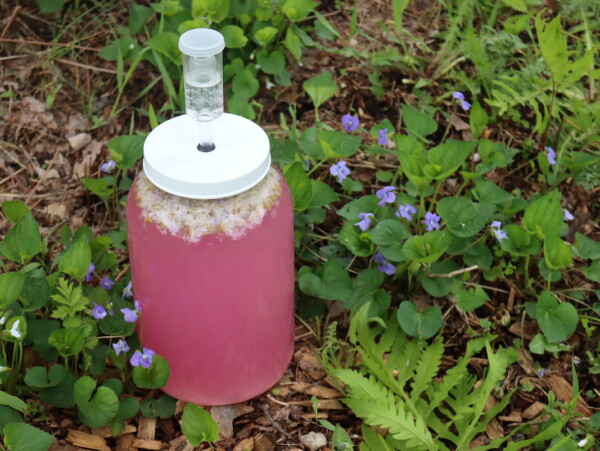
Hello! I made quite a bit of wine last summer with wild grape leaves. It’s been racked maybe about three times and I haven’t backsweetened this gallon yet. It’s pretty dry and a little thin tasting (possibly lacking “body”?) but I was hoping to sweeten it with honey and infuse some citrus and floral flavors into it before bottling. Any recommendations or tips?
This article has some tips for backsweetening. I’m not super experienced with infusing flavors in after the fermentation process but I would definitely be interested in hearing more about how it works out for you.
1
Hi, I have made 2 23 liters rhubarb wine . On May 29th I checked gravity and it was at 1070 for both primary fermenter. June 20th I added more wine yeast and nutrients to get fermentation activated. Nothing is happening. July 3rd. I wonder what can I do now.
Please help.
I’m sorry I didn’t see this sooner. How is your wine doing? Have you tasted it?